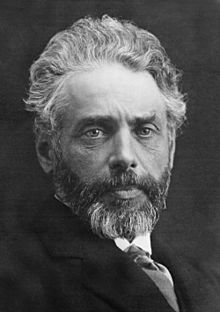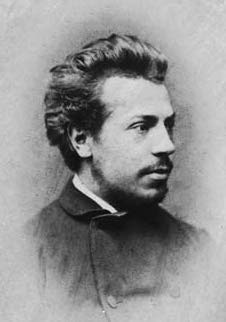Henrik Pontoppidan facts for kids
Quick facts for kids
Henrik Pontoppidan
|
|
|---|---|

Pontoppidan c. 1913
|
|
| Born | 24 July 1857 Fredericia, Denmark |
| Died | 21 August 1943 (aged 86) Charlottenlund, Denmark |
| Nationality | Danish |
| Genre | Realist writer |
| Notable awards | Nobel Prize in Literature 1917 shared with Karl Gjellerup |
| Signature | |
Henrik Pontoppidan (born July 24, 1857 – died August 21, 1943) was a famous Danish writer. He wrote stories that showed real life in Denmark. In 1917, he won the Nobel Prize for Literature with Karl Gjellerup.
Pontoppidan's books and short stories painted a full picture of Denmark during his time. He wanted to see society improve, but later in life, he felt sad that changes were slow. He was a unique writer, different from both his traditional family and his friends who wanted big social changes. He was a key figure in a literary movement called the "Modern Break-Through."
Contents
Early Life and Writing Career
Henrik Pontoppidan came from a family of church ministers and writers. His father was a vicar in Jutland, Denmark. Henrik first studied to become an engineer, but he changed his mind. He worked as a primary school teacher for a while.
Later, he became a freelance journalist and a full-time writer. His first works were published in 1881. In his early writings, he often criticized society. This was also a way of rebelling against his own privileged background.
Pontoppidan wrote short stories that showed the tough lives of farmers and poor country people. He lived close to them and described their lives honestly. He was one of the first Danish writers to show farmers as they really were, not just in an ideal way.
These early stories are in collections like Landsbybilleder ("Village Pictures," 1883) and Fra Hytterne ("From the Huts," 1887). His 1890 collection Skyer ("Clouds") was very political. It described Denmark under a strict government. He criticized both the rulers and the people for not fighting back.
After this period, he started focusing more on people's thoughts and feelings. He still cared about social issues, but his stories became more about inner struggles.
Family Life
Henrik Pontoppidan's first wife was Mette Marie Hansen. She came from a farming family. They had three children together, but one died young. They separated in 1889.
He then met Antoinette Caroline Elise Kofoed and married her in 1892. They had a daughter and a son. Antoinette had poor health and passed away in 1928. Pontoppidan had to support two families, which was often difficult. Both of his sons moved away from Denmark. One went to the U.S., and the other to Brazil.
Major Novels and Themes
Pontoppidan's three most important novels were written between 1890 and 1920. In these books, he created a Danish style of "big society novels." These were like the works of famous writers Balzac and Zola.
His novels followed a main character and showed Denmark during a time of big changes. This included political fights between different groups, new factories, cultural disagreements, and new movements for change.
- Det forjættede Land (1891–95, "The Promised Land") is about a man who dreams of being a preacher in the countryside. His dream leads him to trick himself and eventually causes him to become unwell.
- Lykke-Per (1898–1904, "Lucky Per") is perhaps his most famous book. It's partly based on his own life. It tells the story of a talented man who leaves his religious family. He wants to be an engineer and achieve great things. But even when he is successful, his past catches up to him. He gives up his career to find peace alone.
- De dødes Rige (1912–16, "The Realm of the Dead") is a more serious book. It shows Denmark after democracy seemed to win in 1901. The story focuses on a young, sick landowner who has hopeful plans for reform but struggles with a difficult love.
Other Notable Works
Pontoppidan also wrote many shorter novels and long tales. In these, he explored political ideas and people's minds.
- Isbjørnen (1887, "The Polar Bear") describes a strong-spoken church minister from Greenland. He faces problems with the narrow-minded ministers in a small Danish town.
- Mimoser (1886, "The Apothecary’s Daughters") is a sad and funny story about how people can be too strict about loyalty.
- Nattevagt (1894, "Night Watch") is about a brave artist who wants to change things. But he struggles in his marriage. Pontoppidan based this character on his friend, the painter L. A. Ring. This caused their friendship to end.
- Ørneflugt (1899, "Eagles flight") is a direct comment on Hans Christian Andersen's "The Ugly Duckling". But it has the opposite message. An eagle raised in a farmyard gets fat and dies crashing into a pile of dung. The story means that where you grow up can be more important than what you are born as.
A main idea in many of these stories is the challenge of new ideas. These include tolerance, open-mindedness, and democracy. Another idea is the conflict between quiet, reserved men and lively, energetic women. Pontoppidan often showed how a person's background and surroundings affect them. In his later works, he sometimes seemed to criticize society and warn about future problems.
From 1933 to 1943, Pontoppidan wrote his Memoirs. In these books, he explained his own life journey. Even when he was older and couldn't see or hear well, he stayed interested in politics and culture.
Literary Impact and Influence

Pontoppidan's writing style was very natural and realistic. His language seemed simple, but it often had hidden meanings, symbols, and quiet jokes. He often rewrote his earlier works, making them simpler or changing the story.
Even though he was known for having strong opinions, Pontoppidan is still one of the most discussed Danish writers. This is partly because of his unique personality. He was full of contradictions: a strong supporter of freedom, but also a proud patriot. He was against the church but very strict in his morals. He worked with socialists but always kept his own independent ideas.
His writing style also made him hard to understand sometimes. His mix of personal views and objective descriptions often confused readers and critics. People from different political groups have all tried to find their own ideas in his books.
Among all the writers of the "Modern Break-Through," Pontoppidan is probably the most important and lasting. His writings that criticized society made him a leader in Danish literature of the 20th century. He also set a high standard for "novels about society" that are still important today.
Fun Facts
- Henrik Pontoppidan first studied to be a civil engineer. In 1876, he wanted to join an expedition to Greenland. Another student was chosen instead of him. Pontoppidan was very upset and quit his studies. It's said that because he wasn't chosen for the expedition, he became famous as a writer instead. The other student who went on the expedition sadly died during it.
- Pontoppidan's brother's daughter-in-law was the famous Danish actress Clara Pontoppidan.
- His brother, Knud Pontoppidan, was a well-known psychiatrist and doctor.
- He was related to the famous priest Erik Pontoppidan.
- Pontoppidan is buried in his family's grave in the cemetery of Rørvig Kirke.
- The name Pontoppidan is a Latin version of the Danish name Broby. Broby means "Bridge (by the) City." Henrik Pontoppidan made fun of this practice. He called it a "ridiculous Peacockish plumage."
English Translations
- Emanuel, or Children of the Soil, (Novel), J. M. Dent, London, 1896.
- Lucky Per, (Novel), translated by Naomi Lebowitz, Peter Lang, 2010.
- The Apothecary's Daughters, (Novel), The British Library, 2010.
- A Fortunate Man, (Lykke Per, Novel), translated by Paul Larkin, University of Chicago Press, 2018.
See also
 In Spanish: Henrik Pontoppidan para niños
In Spanish: Henrik Pontoppidan para niños


